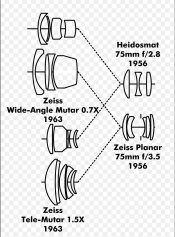Dan Daniel
Subscriber
Below is the part. It is commonly referred to as a bellows because in between the top and bottom metal rings is a piece of clothe that folds in and out as the lens is retracted and extended (not for sale).
The discussion of velvet and such will get you nowhere on this model. It is not built like most other Rolleis (similar bellows are on the TeleRollei and some models of the 3.5F Rollei, not sure if it was random selection, using up parts, or what on Rollei's part). I've made new bellows like this using material cut from a changing bag. If you want a template file or a new piece of clothe, send me a note.
All in all I would send it back. Lots going wrong in that camera and you haven't even opened it up yet. If you haven't taken the lens panel off of a early '50s Rolleiflex before, the C is not a good model to learn on. More fussy than others, a few unusual decisions like the bellows, etc. Get an MX Automat and work on it first.
The discussion of velvet and such will get you nowhere on this model. It is not built like most other Rolleis (similar bellows are on the TeleRollei and some models of the 3.5F Rollei, not sure if it was random selection, using up parts, or what on Rollei's part). I've made new bellows like this using material cut from a changing bag. If you want a template file or a new piece of clothe, send me a note.
All in all I would send it back. Lots going wrong in that camera and you haven't even opened it up yet. If you haven't taken the lens panel off of a early '50s Rolleiflex before, the C is not a good model to learn on. More fussy than others, a few unusual decisions like the bellows, etc. Get an MX Automat and work on it first.






